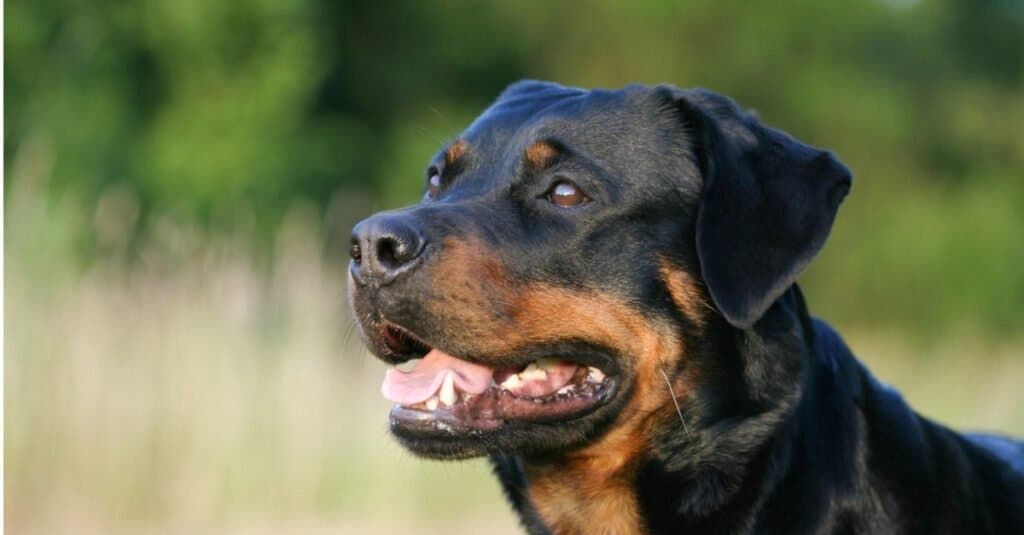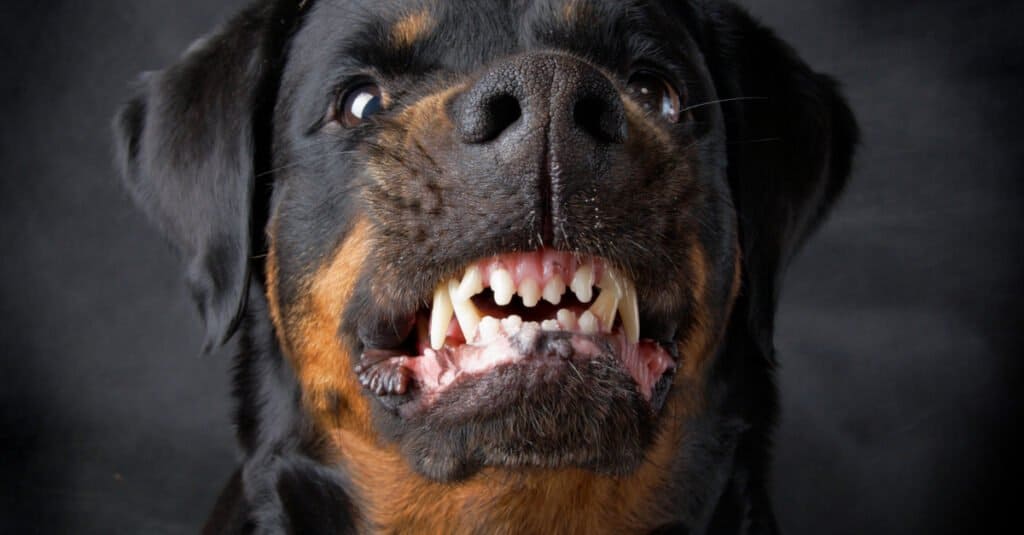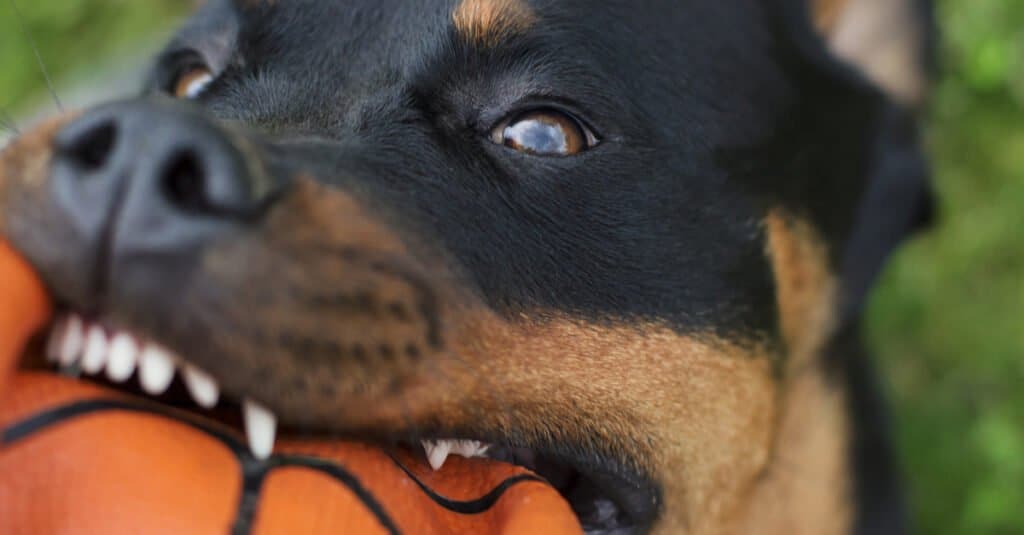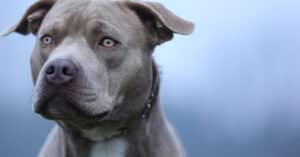The Rottweiler has gained a distinct reputation over the years as one of the strongest dogs on the planet, and it deserves every inch of the spotlight. Rottweilers have cute faces, especially when puppies, and grow up to be handsome and fierce-looking dogs that are always alert and ready to protect, making them the best choice for a guard dog. Apart from their undeniable strength and wit, what also makes them fearsome is their set of long, sharp teeth. Rottweiler teeth aren’t the only frightening thing about these aggressive dogs; their bite force is also one of the strongest bite forces in all dog breeds, thanks to their massive heads and jaws.
Despite all that, rottweilers are loving, affectionate, and cheerful. They are often turned into working dogs as they have the wit and authoritative behavior to herd. Rottweilers also make good police dogs because of their heightened sense of smell and heavily-muscled bodies that can chase down any threat. They are also easy to train as they are smart, submissive, and eager to work. Despite their mightiness and fearsome facade, Rottweilers are one of the most prone to dental diseases among other dog breeds, so proper hygiene and dental care are crucial for these canine giants.
What Kind of Teeth Do Rottweilers Have?

Rottweilers, like other dogs, have heterodont teeth which they use to cut and chew food.
©iStock.com/Jana Richter
Like all dog breeds and most mammals, Rottweilers have a complete set of heterodont teeth, including incisors, canines, premolars, and molars. The three pairs of incisors or front teeth are used for nibbling and cutting food. They are located between the two pairs of canines, evenly distributed at both sides of the upper and lower jaws. The Rottweiler’s center incisors at both top and bottom jaws are smaller than the others, and the rest of the incisors become more significant as they move away from the center and get closer toward the canines. This means that the biggest incisors are the ones closest to canine teeth.
The two pairs of canine teeth are resembled as long fangs. The Rottweiler’s canine teeth hold on food and tear them. Since domesticated and wild dogs are originally carnivores, their canines are designed to be sharp enough to grab and hold onto prey. However, since Rottweilers often feed on pet food and some chunks of meat, they barely use these canines in hunting. The Rottweiler’s canines are long and sharp enough to tear its meat or flesh food apart, chew on toys and other things, and bite on animals or even humans when attacking.
On the other hand, the Rottweiler’s premolars have sharp, cutting-edges (known as carnassial teeth) that help them cut and shear their food. Unlike herbivores who usually sport flat-crowned cheek teeth, the Rottweiler’s premolars are designed sharp so that they can tear their food even better. The molars are positioned towards the back of the mouth to help in further grinding and chewing of food. Adult rottweilers have 4 molars on the upper jaw and 6 at the lower jaw.
How Many Teeth Do Rottweilers Have?

Rottweilers, like most dogs, have 42 teeth.
©Tatiana Makotra/Shutterstock.com
Adult Rottweilers have 42 teeth, while Rottweiler puppies have only 28. As mammals with diphyodont dentition, Rottweilers grow two sets of teeth in one lifetime. The first or deciduous set of teeth only has 28 teeth and is much smaller than the adult ones. As the Rottweiler puppy ages and sheds its baby teeth, permanent ones will appear in their place, and other teeth (molars) will appear as well, completing the process in about 6-9 months and creating a dental formula of 2 (Incisors 3/3, Canines 1/1, Premolars 4/4, Molars 2/3) = 42. This all happens in a process called “teething.”
Adult Rottweilers have 20 teeth in their upper jaw and 22 in the lower jaw, including 12 incisors, 4 canines, 16 premolars, and 10 molars. The correct alignment of the Rottweiler’s front teeth should appear like scissors. However, some abnormalities like retained baby teeth can push the adult incisors out of alignment, thus hindering a scissor bite. The scissor bite is the standard shape that the Rottweiler’s teeth should have, wherein the upper incisors fall perfectly in front of the lower front teeth. The premolars should also interlock in a saw-like fashion, while the canine teeth are supposed to intersect with each other, creating a delicate curve.
Apart from indicating that the Rottweiler has the right amount of teeth in the proper alignment, a proper scissor bite also helps rottweilers eat properly and quickly grab things. Malocclusion or improper bite is a common dental problem in dogs that can affect how they eat, chew, and close their mouths.
How Strong is a Rottweiler’s Bite?

Rottweilers are one of the most dangerous
dog breeds
, having a bite force of 328 PSI.
©Jan Mlkvy/Shutterstock.com
With their tall physique, reaching up to 25 inches tall, to their hefty, muscular bodies, weighing up to 120 pounds, it isn’t surprising that Rottweilers possess one of the highest and strongest bite forces among all domesticated dog breeds. Rottweilers can deliver a whopping 328 PSI bite force, making them one of the most dangerous dog breeds. They are well-regarded as therapy dogs because of their loving and caring nature, but once these mighty canines work as guards or police dogs, they indeed are reliable in chasing down and attacking bad people.
Common Dental Problems in Rottweilers
Rottweilers are more vulnerable to dental problems than any other dog breed. They are susceptible to having foul mouth odor, loosened teeth, bleeding gums, retreating gums, malocclusion, and plaque and tartar build-up. Rottweilers have a common problem of misaligned teeth which can get in the way of feeding and biting. Plaque and tartar build-up can be dangerous if not acted upon quickly because they can eventually spread and eat the gum tissues away, resulting in loosened teeth. To avoid such dental problems, Rottweiler owners can offer them femur bones to chew on, which helps clean their teeth naturally.
The photo featured at the top of this post is © Lukas Gojda/Shutterstock.com
Ready to discover the top 10 cutest dog breeds in the entire world?
How about the fastest dogs, the largest dogs and those that are -- quite frankly -- just the kindest dogs on the planet? Each day, AZ Animals sends out lists just like this to our thousands of email subscribers. And the best part? It's FREE. Join today by entering your email below.
Thank you for reading! Have some feedback for us? Contact the AZ Animals editorial team.






